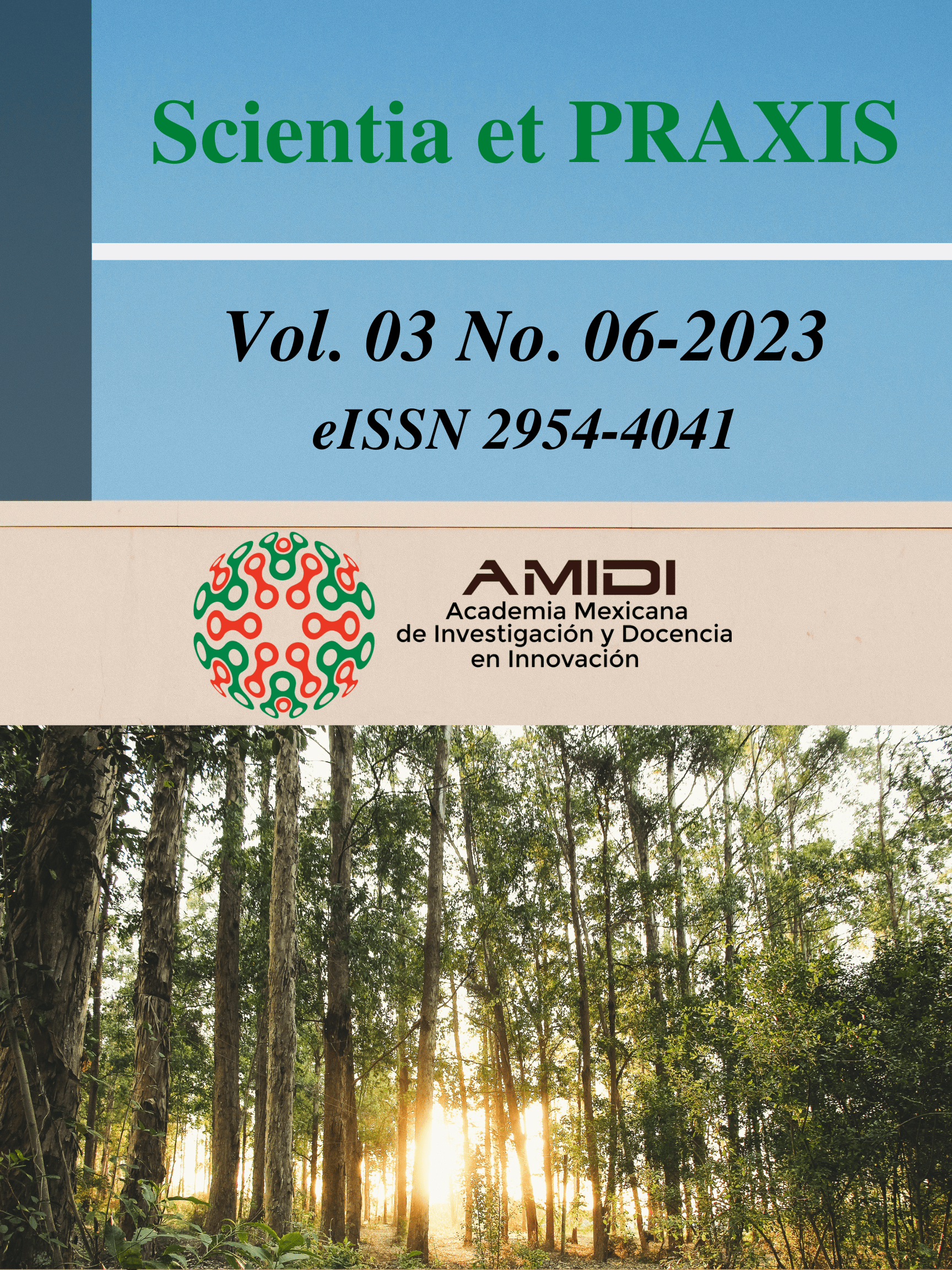Open Innovation Effects in Eco-innovation and Business Performance in Mexican Manufacturing Firms
DOI:
https://doi.org/10.55965/setp.3.06.a1Keywords:
open innovation, eco-innovation, business performance, manufacturing firmsAbstract
Context. The global problems of environmental degradation and climate change are leading organizations to adopt and apply new production strategies to improve their innovation activities. Among the different business strategies recently proposed in the literature, open innovation and eco-innovation stand out, for which there is still no certainty in the innovation literature that they can generate better results in organizations. For this reason, future studies need to provide empirical evidence in favor of this relationship.
Objective. Explore the link between open innovation, eco-innovation activities, and business performance.
Problem. Would it be possible to establish that the adoption and implementation of open innovation and eco-innovation improve business performance in manufacturing firms in Mexico?
Methodology. The Methodology practically consisted of carrying out a quantitative investigation, reviewing recently published articles in high-impact international journals, and a sample framework comprising three measurement scales, 27 items, and two hypotheses that were tested by applying 460 surveys to companies in the automotive sector, between January to March 2021.
Theoretical and Practical Findings. The findings of this study corroborate our argument that firms that have adopted and applied open innovation and eco-innovation have managed to increase their level of business performance significantly.
Transdisciplinary and sustainable innovation originality. By applying 460 surveys between January to March 2021, the same number of organizations, this study contributes to expanding the limited knowledge in the literature about the link between open innovation and eco-innovation and its impact on business performance.
Conclusions and limitations. The estimation of the data derived from the 460 surveys applied in 2021 to the same number of companies provides empirical evidence that allows us to conclude that the close link between open innovation and eco-innovation contributes to a substantial increase in the level of business performance of companies.
Downloads
References
Abdullah, I., Mahmood, W.H.W., Fauadi, H.F.M., Rahman, M.N.A. y Mohamed, S.B. (2017). Sustainable manufacturing practices in Malaysian palm oil mills: Priority and current performance. Journal of Manufacturing Technology Management, 28(3), 278-298. https://doi.org/10.1108/JMTM-09-2016-0128 DOI: https://doi.org/10.1108/JMTM-09-2016-0128
Anderson, J. y Gerbing, D. (1988). Structural equation modeling in practice: A review and recommended two-step approach. Psychological Bulletin, 13(1), 411-423. https://doi.org/10.1037/0033-2909.103.3.411 DOI: https://doi.org/10.1037/0033-2909.103.3.411
Arnold, M. (2017). Fostering sustainability by linking co-creation and relationship management concepts. Journal of Cleaner Production, 140(1), 179-188. https://doi.org/10.1016/j.jclepro.2015.03.059 DOI: https://doi.org/10.1016/j.jclepro.2015.03.059
Bag, S. (2014). Impact of sustainable supply chain management on organizational performance: Mediating effects of leadership. Indian Journal of Management Science, 4(3), 10-25. https://www.proquest.com/openview/8f8ca2dce9415d4a3c593229ee0a3d89/1?pq-origsite=gscholar&cbl=2032141
Bhatia, M.S. y Awasthi, A. (2018). Assessing relationship between quality management systems and business performance and its mediators: SEM approach. International Journal of Quality & Reliability Management, 35(8), 1490-1507. https://doi.org/10.1108/IJQRM-05-2017-0091 DOI: https://doi.org/10.1108/IJQRM-05-2017-0091
Bossle, M.B., De Barcellos, M.D. y Vieira, L.M. (2016). Why food companies go green? The determinant factors to adopt eco-innovations. British Food Journal, 118(6), 1317-1333. https://doi.org/10.1108/BFJ-10-2015-0388 DOI: https://doi.org/10.1108/BFJ-10-2015-0388
Castillo-Esparza, M.M.G.C., Cuevas-Pichardo, L.J. y Montejano-García, S. (2022). Innovación en México: Patentes, gastos en I+D y capital humano. Scientia et PRAXIS, 2(4), 82-103. https://doi.org/10.55965/setp.2.coed.a4 DOI: https://doi.org/10.55965/setp.2.coed.a4
Cheng, C.C.J. y Shiu, E.C. (2020). Leveraging open innovation strategies for fueling eco-innovation performance in dynamic environments. Sustainable Accounting Management Policy, 11(7), 1245-1270. https://doi.org/10.1108/SAMPJ-04-2018-0103 DOI: https://doi.org/10.1108/SAMPJ-04-2018-0103
Chesbrough, H. (2017a). The future of open innovation: The future of open innovation is more extensive, more collaborative, and more engaged with a wider variety of participants. Responsible Technology Management, 60(1), 35-38. https://doi.org/10.1080/08956308.2017.1255054 DOI: https://doi.org/10.1080/08956308.2017.1255054
Chesbrough, H. (2017b). Interview with prof. Henry Chesbrough: An exciting time for open innovation in the energy sector. European Institute of Innovation and Technology. http://eit.europa.eu/newsroom-hnry-chesbrough-open-innovation. Retrieved 23 October 2021.
Chistov, V., Carrillo-Hermosilla, J., y Aramburu, N. (2023). Open eco-innovation: Aligning cooperation and external knowledge with the levels of eco-innovation radicalness. Journal of Open Innovation: Technology, Market, and Complexity, 9(1), 1-15. https://doi.org/10.1016/j.joitmc.2023.100049 DOI: https://doi.org/10.1016/j.joitmc.2023.100049
Crema, M., Verbano, C. y Venturini, K. (2014). Linking strategy with open innovation and performance in SMEs. Measuring Business Excellence, 18(2), 14-27. https://doi.org/10.1108/MBE-07-2013-0042 DOI: https://doi.org/10.1108/MBE-07-2013-0042
Cuerva, M.C., Triguero, C.A. y Córcoles, D. (2014). Drivers of green and non-green innovation: Empirical evidence in low-tech SMEs. Journal of Cleaner Production, 68(1), 104-113. https://doi.org/10.1016/j.jclepro.2013.10.049 DOI: https://doi.org/10.1016/j.jclepro.2013.10.049
de Medeiros, J.F., Ribeiro, J.L. y Cortimiglia, M.N. (2014). Success factors for environmentally sustainable product innovation: A systematic literature review. Journal of Cleaner Production, 65(1), 76-86. https://doi.org/10.1016/j.jclepro.2013.08.035 DOI: https://doi.org/10.1016/j.jclepro.2013.08.035
del Río, P., Romero-Jordán, D. y Peñasco, C. (2017). Analyzing firm-specific and type-specific determinants of eco-innovation. Technology Economic and Development Economy, 23(2), 270-295. ttps://doi.org/10.3846/20294913.2015.1072749 DOI: https://doi.org/10.3846/20294913.2015.1072749
Díaz-García, C., González-Moreno, A. y Sáez-Martínez, F.J. (2015). Eco-innovation: Insights from a literature review. Innovation Management and Policy Practice, 17(1), 6-23. https://doi.org/10.1080/14479338.2015.1011060 DOI: https://doi.org/10.1080/14479338.2015.1011060
Fornell, C. y Larcker, D. (1981). Evaluating structural equation models with unobservable variables and measurement error. Journal of Marketing Research, 18(1), 39-50. https://doi.org/10.1177/0022243781018001 DOI: https://doi.org/10.1177/002224378101800104
Fuzi, N.M., Habidin, N.F. y Ong, S.Y.Y. (2018). Corporate social responsibility practices in Malaysian automotive suppliers: Confirmatory factor analysis. International Journal of Business Excellence, 15(2), 222-238. https://doi.org/10.1504/IJBEX.2018.091922 DOI: https://doi.org/10.1504/IJBEX.2018.091922
García, R., Wigger, K. y Rivas, H. R. (2019). Challenges of creating and capturing value in open eco-innovation: Evidence from the maritime industry in Denmark. Journal of Cleaner Production, 220(1), 642-654. https://doi.org/10.1016/j.jclepro.2019.02.027 DOI: https://doi.org/10.1016/j.jclepro.2019.02.027
Hair, J., Black, W., Babin, B. y Anderson, R. (2019). Multivariate Data Analysis. 8th Edition. London: Cengage.
Hojnik, J., Ruzzier, M. y Lipnik, A. (2014). Pursuing eco-innovation within southeastern European clusters. The IUP Journal of Business Strategy, 11(3), 41-59.
Huizingh, E.K. (2011). Open innovation: State of the art and future perspective. Technovation, 31(1), 2-9. https://doi.org/10.1016/j.technovation.2010.10.002 DOI: https://doi.org/10.1016/j.technovation.2010.10.002
Jakobsen, S. y Clausen, T.H. (2016). Innovating for a greener future: The direct and indirect effects on firms’ environmental objectives on the innovation process. Journal of Cleaner Production, 128(1), 131-141. https://doi.org/10.1016/j.jclepro.2015.06.023 DOI: https://doi.org/10.1016/j.jclepro.2015.06.023
Kastelli, I., Tsakanikas, A. y Caloghirou, Y. (2016). Technology transfer as a mechanism for dynamic transformation in the food sector. Journal of Technology Transfer, 10(1), 1-19. https://doi.org/10.1007/s10961-016-9530-3 DOI: https://doi.org/10.1007/s10961-016-9530-3
Lawson, B. y Samson, D. (2001). Developing innovation capabilities in organizations: A dynamic capabilities approach. International Journal of Innovation Management, 5(3), 377-400. https://doi.org/10.1142/S1363919601000427 DOI: https://doi.org/10.1142/S1363919601000427
Leitao, J., Pereira, D. y de Brito, S. (2020). Inbound and outbound practices of open innovation and eco-innovation: Contrasting bioeconomy and non-bioeconomy firms. Journal of Open Innovation: Technology, Market, and Complexity, 6(4), 1-34. https://doi.org/10.3390/joitmc6040145 DOI: https://doi.org/10.3390/joitmc6040145
Lichtenthaler, U., Ernst, H. y Hoegl, M. (2010). Not-sold here: How attitudes influence external knowledge exploitation. Organizational Science, 21(1), 1054-1071. https://doi.org/10.1287/orsc.1090.0499 DOI: https://doi.org/10.1287/orsc.1090.0499
Manzini, R., Lazzarotti, V. y Pellegrini, L. (2017). How to remain as closed as possible in the open innovation era: The case of Lindt & Sprüngli. Long Range Planning, 50(1), 260-281. https://doi.org/10.1016/j.lrp.2015.12.011 DOI: https://doi.org/10.1016/j.lrp.2015.12.011
Mustaquim, M.M. y Nyström, T. (2014). Defining information systems for sustainability: The role of universal design and open innovation. Lecture Notes in Computer Science, 84(1), 1-16. https://doi.org/10.1007/978-3-319-06701-8_1 DOI: https://doi.org/10.1007/978-3-319-06701-8_1
Nosratabadi, S., Mosavi, A., Shamshirband, S., Zavadskas, E.K., Rakotonirainy, A. y Chau, K.W. (2019). Sustainable business models: A review. Sustainability, 11(6), 1-30. https://doi.org/10.3390/su11061663 DOI: https://doi.org/10.3390/su11061663
Patel, M. y Desai, D.A. (2018). Critical review and analysis of measuring the success of six sigma implementation in manufacturing sector. International Journal of Quality & Reliability Management, 35(8), 1519-1545. https://doi.org/10.1108/IJQRM-04-2017-0081 DOI: https://doi.org/10.1108/IJQRM-04-2017-0081
Rauter, R., Globocnik, D., Perl-Vorbach, E. y Baumgartner, R.J. (2018). Open innovation and its effects on economic ads sustainability innovative performance. Journal of Innovation & Knowledge (2018). https://doi.org/10.1016/j.jik.2018.03.004 DOI: https://doi.org/10.1016/j.jik.2018.03.004
Salazar-Soto, H., y Pinzón-Castro, S.D. (2023). Eco-innovación y responsabilidad social empresarial: Un estudio biliométrico de la relación de estos constructos. Scientia et PRAXIS, 3(5), 34-59. https://doi.org/10.55965/setp.3.05.a2 DOI: https://doi.org/10.55965/setp.3.05.a2
Sardi, A., Sorano, E., Ferraris, A. y Garengo, P. (2020). Evolutionary paths of performance measurement and management system: The longitudinal case study of a leading SME. Measuring Business Excellence, 24(4), 495-510. https://doi.org/10.1108/MBE-01-2020-0016 DOI: https://doi.org/10.1108/MBE-01-2020-0016
Segarra-Oña, M., Peiró-Signes, A. y Payá-Martínez, A. (2014). Factors influencing automobile firm’s eco-innovation orientation. Engineering Management Journal, 26(1), 31-38. https://doi.org/10.1080/10429247.2014.11432002 DOI: https://doi.org/10.1080/10429247.2014.11432002
Singh, S.K., Gupta, S., Busso, D. y Kamboj, S. (2019). Top management knowledge value, knowledge sharing practices, open innovation, and organizational performance. Journal of Business Research, 128(5), 788-798. https://doi.org/10.1016/j.jbusres.2019.04.040 DOI: https://doi.org/10.1016/j.jbusres.2019.04.040
Stefan, I. y Bengtsson, L. (2017). Unraveling appropriability mechanism and openness depth effects on firm performance across stage in the innovation process. Technological Forecasting & Social Change, 120(1), 252-260. https://doi.org/10.1016/j.techfore.2017.03.014 DOI: https://doi.org/10.1016/j.techfore.2017.03.014
Tanguy, C. (2016). Cooperation in the food industry: Contributions and limitations of the open innovation model. Journal of Innovation and Economic Management, 1(1), 61-86. https://doi.org/10.3917/jie.019.0061 DOI: https://doi.org/10.3917/jie.019.0061
Torkkeli, M., Kock, C. y Salmi, P. (2009). The open innovation paradigm: A contingency perspective. Journal of Industrial Engaged Management, 2(1), 176-207. doi:10.3926/jiem.v2n1.p176-207 DOI: https://doi.org/10.3926/jiem.2009.v2n1.p176-207
Triguero, A., Fernández, S. y Sáez-Martínez, F. (2018). Inbound open innovative strategies and eco-innovation in the Spanish food and beverage industry. Sustainable Production and Consumption, 15(1), 49-64. https://doi.org/10.1016/j.spc.2018.04.002 DOI: https://doi.org/10.1016/j.spc.2018.04.002
Tsai, K.H. y Liao, Y.C. (2017). Sustainability strategy and eco-innovation: A moderation model. Business Strategy and the Environment, 26(1), 426-437. https://doi.org/10.1002/bse.1926 DOI: https://doi.org/10.1002/bse.1926
Tucci, C.L., Chesbrough, H., Piller, F., y West, J. (2016). When do firms undertake open, collaborative activities? Introduction to the special section on open innovation and open business models. Industrial Corporation and Change, 25(2), 283-288. https://doi.org/10.1093/icc/dtw002 DOI: https://doi.org/10.1093/icc/dtw002
Valdez-Juárez, L.E. y Castillo-Vergara, M. (2021). Technological capabilities, open innovation, and eco-innovation: Dynamic capabilities to increase corporate performance of SMEs. Journal of Open Innovation: Technology, Market, and Complexity, 7(8), 1-19. https://doi.org/10.3390/joitmc7010008 DOI: https://doi.org/10.3390/joitmc7010008
van de Vrande, V., de Jong, P.J., Vanhaverbeke, W. y de Rochemont, M. (2009). Open innovation in SMEs: Trends, motives, and management challenges. Technovation, 29(1), 423-437. https://doi.org/10.1016/j.technovation.2008.10.001 DOI: https://doi.org/10.1016/j.technovation.2008.10.001
Westman, L., Luederitz, C., Kundurpi, A., Mercado, A.J., y Burch, S.L. (2022). Market transformations as collaborative change: Institutional co-evolution through small business entrepreneurship. Business Strategy and the Environment, 32(2), 936-957. https://doi.org/10.1002/bse.3083 DOI: https://doi.org/10.1002/bse.3083
Xin, X., Miao, X. y Cui, R. (2022). Enhancing sustainable development: Innovation eco-system coopetition, environmental resource orchestration, and disruptive green innovation. Business Strategy and the Environment, 32(4), 1388-402. https://doi.org/10.1002/bse.3194 DOI: https://doi.org/10.1002/bse.3194
Zhang, D., Rong, Z. y Ji, Q. (2019). Green innovation and firm performance: Evidence from listed companies in China. Resource, Conservation & Recycling, 144(1), 48-55. https://doi.org/10.1016/j.resconrec.2019.01.023 DOI: https://doi.org/10.1016/j.resconrec.2019.01.023
Published
How to Cite
Issue
Section
License
Copyright (c) 2023 Sandra Yesenia Pinzón-Castro, Gonzalo Maldonado-Guzmán

This work is licensed under a Creative Commons Attribution-NonCommercial 4.0 International License.











